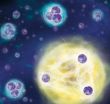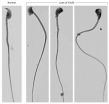(Press-News.org) Controversy over what sparked the Younger Dryas, a brief return to near glacial conditions at the end of the Ice Age, includes a theory that it was caused by a comet hitting the Earth.
As proof, proponents point to sediments containing deposits they believe could result only from a cosmic impact.
Now a new study disproves that theory, said archaeologist David Meltzer, Southern Methodist University, Dallas. Meltzer is lead author on the study and an expert in the Clovis culture, the peoples who lived in North America at the end of the Ice Age.
Meltzer's research team found that nearly all sediment layers purported to be from the Ice Age at 29 sites in North America and on three other continents are actually either much younger or much older.
Scientists agree that the brief episode at the end of the Ice Age — officially known as the Younger Dryas for a flower that flourished at that time — sparked widespread cooling of the Earth 12,800 years ago and that this cool period lasted for 1,000 years. But theories about the cause of this abrupt climate change are numerous. They range from changes in ocean circulation patterns caused by glacial meltwater entering the ocean to the cosmic-impact theory.
The cosmic-impact theory is said to be supported by the presence of geological indicators that are extraterrestrial in origin. However a review of the dating of the sediments at the 29 sites reported to have such indicators proves the cosmic-impact theory false, said Meltzer.
Meltzer and his co-authors found that only three of 29 sites commonly referenced to support the cosmic-impact theory actually date to the window of time for the Ice Age.
The findings, "Chronological evidence fails to support claim of an isochronous widespread layer of cosmic impact indicators dated to 12,800 years ago," were reported May 12, 2014, in the Proceedings of the National Academy of Sciences.
Co-authors were Vance T. Holliday and D. Shane Miller, both from the University of Arizona; and Michael D. Cannon, SWCA Environmental Consultants Inc., Salt Lake City, Utah.
"The supposed impact markers are undated or significantly older or younger than 12,800 years ago," report the authors. "Either there were many more impacts than supposed, including one as recently as 5 centuries ago, or, far more likely, these are not extraterrestrial impact markers."
Dating of purported Younger Dryas sites proves unreliable
The Younger Dryas Impact Hypothesis rests heavily on the claim that there is a Younger Dryas boundary layer at 29 sites in the Americas and elsewhere that contains deposits of supposed extraterrestrial origin that date to a 300-year span centered on 12,800 years ago.
The deposits include magnetic grains with iridium, magnetic microspherules, charcoal, soot, carbon spherules, glass-like carbon containing nanodiamonds, and fullerenes with extraterrestrial helium, all said to result from a comet or other cosmic event hitting the Earth.
Meltzer and his colleagues tested that hypothesis by investigating the existing stratigraphic and chronological data sets reported in the published scientific literature and accepted as proof by cosmic-impact proponents, to determine if these markers dated to the onset of the Younger Dryas.
They sorted the 29 sites by the availability of radiometric or numeric ages and then the type of age control, if available, and whether the age control is secure.
The researchers found that three sites lack absolute age control: at Chobot, Alberta, the three Clovis points found lack stratigraphic context, and the majority of other diagnostic artifacts are younger than Clovis by thousands of years; at Morley, Alberta, ridges are assumed without evidence to be chronologically correlated with Ice Age hills 2,600 kilometers away; and at Paw Paw Cove, Maryland, horizontal integrity of the Clovis artifacts found is compromised, according to that site's principal archaeologist.
The remaining 26 sites have radiometric or other potential numeric ages, but only three date to the Younger Dryas boundary layer.
At eight of those sites, the ages are unrelated to the supposed Younger Dryas boundary layer, as for example at Gainey, Michigan, where extensive stratigraphic mixing of artifacts found at the site makes it impossible to know their position to the supposed Younger Dryas boundary layer. Where direct dating did occur, it's sometime after the 16th century A.D.
At Wally's Beach, Alberta, a radiocarbon age of 10,980 purportedly dates extraterrestrial impact markers from sediment in the skull of an extinct horse. In actuality, the date is from an extinct musk ox, and the fossil yielding the supposed impact markers was not dated, nor is there evidence to suggest that the fossils from Wally's Beach are all of the same age or date to the Younger Dryas onset.
At nearly a dozen other sites, the authors report, the chronological results are neither reliable nor valid as a result of significant statistical flaws in the analysis, the omission of ages from the models, and the disregard of statistical uncertainty that accompanies all radiometric dates.
For example, at Lake Cuitzeo, Mexico, Meltzer and his team used the data of previous researchers and applied a fifth-order polynomial regression, but it returned a different equation that put the cosmic-impact markers at a depth well above that which would mark the Younger Dryas onset.
The authors go on to point out that inferences about the ages of supposed Younger Dryas boundary layers are unsupported by replication in more cases than not.
In North America, the Ice Age was marked by the mass extinction of several dozen genera of large mammals, including mammoths, mastodons, American horses, Western camels, two types of deer, ancient bison, giant beaver, giant bears, sabre-toothed cats, giant bears, American cheetahs, and many other animals, as well as plants.
INFORMATION:
Meltzer is the Henderson-Morrison Professor of Prehistory in SMU's Dedman College and a member of the National Academy of Sciences.
Follow SMUResearch.com on Twitter, @smuresearch
For more information, http://www.smuresearch.com
SMU is a nationally ranked private university in Dallas founded 100 years ago. Today, SMU enrolls nearly 11,000 students who benefit from the academic opportunities and international reach of seven degree-granting schools. For more information see http://www.smu.edu.
SMU has an uplink facility located on campus for live TV, radio, or online interviews. To speak with an SMU expert or book an SMU guest in the studio, call SMU News & Communications at 214-768-7650.
Comet theory false; doesn't explain Ice Age cold snap, Clovis changes, animal extinction
Most supposed impact indicators at 29 sites are too old or too young to be remnants of an ancient comet that proponents claim sparked climate change at the end of the Ice Age, killed America's earliest people and caused a mass animal extinction
2014-05-13
ELSE PRESS RELEASES FROM THIS DATE:
Chemists design molecules for controlling bacterial behavior
2014-05-13
Chemists in the College of Arts and Sciences have figured out how to control multiple bacterial behaviors—potentially good news for the treatment of infectious diseases and other bacteria-associated issues, without causing drug resistance.
Yan-Yeung Luk, associate professor of chemistry, has spearheaded the discovery, in conjunction with his research lab at Syracuse University and the Wang Lab at SUNY Upstate Medical University. Their findings are the subject of a forthcoming article in the journal ChemBioChem (John Wiley & Sons Inc.).
"Since the discovery of the first ...
UCSF: E-cigarettes expose people to more than harmless vapor, should be regulated
2014-05-13
In a major scientific review of research on e-cigarettes, UC San Francisco scientists found that industry claims about the devices are unsupported by the evidence to date, including claims that e-cigarettes help smokers quit.
The review marks the first comprehensive assessment of peer-reviewed published research into the relatively new phenomenon of electronic cigarettes.
The devices, which are rapidly gaining a foothold in popular culture particularly among youth, are marketed as a healthier alternative to tobacco smoking, as an effective tool to stop smoking, ...
Scientists from USC and NYU design a molecule that blocks cancer growth in mice
2014-05-13
A team of researchers from USC and NYU has developed and patented a small molecule that interferes with cancer progression with minimal side effects.
The molecule prevents two critical proteins from interacting by mimicking the surface topography of one protein – like wearing a mask – which tricks the other protein into binding with it. This stops a so-called "transcription factor" that controls the transcription of genetic information. That transcription factor is what would have created an aberrant gene expression, contributing to the cancer growth.
Because of the ...
Scientists slow brain tumor growth in mice
2014-05-13
Much like using dimmer switches to brighten or darken rooms, biochemists have identified a protein that can be used to slow down or speed up the growth of brain tumors in mice.
Brain and other nervous system cancers are expected to claim 14,320 lives in the United States this year.
The results of the preclinical study led by Eric J. Wagner, Ph.D., and Ann-Bin Shyu, Ph.D., of The University of Texas Health Science Center at Houston (UTHealth) and Wei Li, Ph.D., of Baylor College of Medicine appear in the Advance Online Publication of the journal Nature.
"Our work ...
Birth by C-section, early antibiotic use put kids at risk for allergic esophagitis
2014-05-13
Children delivered by cesarean section and those given antibiotics during early infancy appear more prone to developing allergic inflammation of the esophagus — the muscular tube that connects the mouth to the stomach — according to results of a study by investigators from the Johns Hopkins Children's Center and Harvard Medical School.
The findings, published online May 2 in the Journal of Allergy and Clinical Immunology: In Practice, reveal that early antibiotic treatment and C-section delivery may somehow precipitate disease development by altering a child's microbiota ...
Professional surfer back in the water after successful surgery to treat rare bone cancer
2014-05-13
LOS ANGELES (May 13, 2014) – When professional surfer Richie Lovett began experiencing hip pain at 31, he attributed it to his athletic lifestyle. But after months of discomfort and preliminary tests, the Australian native learned the pain was caused by a cancerous tumor in his femur or thigh bone.
"As a professional athlete, I was blindsided by the news that I had cancer," said Lovett. "I realized very quickly that cancer would have a profound effect on my life. I knew I needed an experienced oncologist to tackle this disease, so I began an international search to find ...
Quantum trimer -- from a distance
2014-05-13
Eight years ago Rudolf Grimm's research group was the first to observe an Efimov state in an ultracold quantum gas. The Russian physicist Vitali Efimov theoretically predicted this exotic bound state of three particles in the 1970s. He forecast that three particles would form a bound state due to their quantum mechanical properties, under conditions when a two-body bound state would be absent. What is even more astounding: When the distance between the particles is increased by factor 22.7, another Efimov state appears, leading to an infinite series of these states. Until ...
Researchers identify link between colon cancer and metabolism
2014-05-13
HEIDELBERG, 13 May 2014 – More than 60 years ago Otto Warburg recognized that cancer cells differ from normal cells in the metabolic pathway they use for the oxidation of sugar. Rather than the typical series of oxidative steps that take place in the citric acid cycle, cancer cells metabolize sugar via the glycolytic pathway irrespective of whether oxygen is present or not. In The EMBO Journal, researchers in the United States report that the reason for this difference in colon cancer is changes in the Wnt signaling pathway, an essential communication pathway operating ...
Dangerous nitrogen pollution could be halved
2014-05-13
Ambitious mitigation efforts, however, could decrease the pollution by 50 percent. The analysis is the very first to quantify this.
"Nitrogen is an irreplaceable nutrient and a true life-saver as it helps agriculture to feed a growing world population – but it is unfortunately also a dangerous pollutant," says Benjamin Bodirsky, lead-author of the study. In the different forms it can take through chemical reactions, it massively contributes to respirable dust, leads to the formation of aggressive ground-level ozone, and destabilizes water ecosystems. Damages in Europe ...
Male infertility: It's all about the package
2014-05-13
Cold Spring Harbor, NY – Infertility is generally thought of as a woman's problem. In fact, more than 3 million men across America also experience it. Today, researchers from Cold Spring Harbor Laboratory (CSHL) describe a key event during sperm development that is essential for male fertility. A team led by CSHL Professor Alea Mills explains how a protein controls DNA packaging to protect a man's genetic information.
The sperm is a simple delivery vehicle for a man's genetic information. The highly specialized cell is little more than a DNA bundle powered by molecular ...
LAST 30 PRESS RELEASES:
Making lighter work of calculating fluid and heat flow
Normalizing blood sugar can halve heart attack risk
Lowering blood sugar cuts heart attack risk in people with prediabetes
Study links genetic variants to risk of blinding eye disease in premature infants
Non-opioid ‘pain sponge’ therapy halts cartilage degeneration and relieves chronic pain
AI can pick up cultural values by mimicking how kids learn
China’s ecological redlines offer fast track to 30 x 30 global conservation goal
Invisible indoor threats: emerging household contaminants and their growing risks to human health
Adding antibody treatment to chemo boosts outcomes for children with rare cancer
Germline pathogenic variants among women without a history of breast cancer
Tanning beds triple melanoma risk, potentially causing broad DNA damage
Unique bond identified as key to viral infection speed
Indoor tanning makes youthful skin much older on a genetic level
Mouse model sheds new light on the causes and potential solutions to human GI problems linked to muscular dystrophy
The Journal of Nuclear Medicine ahead-of-print tip sheet: December 12, 2025
Smarter tools for peering into the microscopic world
Applications open for funding to conduct research in the Kinsey Institute archives
Global measure underestimates the severity of food insecurity
Child survivors of critical illness are missing out on timely follow up care
Risk-based vs annual breast cancer screening / the WISDOM randomized clinical trial
University of Toronto launches Electric Vehicle Innovation Ontario to accelerate advanced EV technologies and build Canada’s innovation advantage
Early relapse predicts poor outcomes in aggressive blood cancer
American College of Lifestyle Medicine applauds two CMS models aligned with lifestyle medicine practice and reimbursement
Clinical trial finds cannabis use not a barrier to quitting nicotine vaping
Supplemental nutrition assistance program policies and food insecurity
Switching immune cells to “night mode” could limit damage after a heart attack, study suggests
URI-based Global RIghts Project report spotlights continued troubling trends in worldwide inhumane treatment
Neutrophils are less aggressive at night, explaining why nighttime heart attacks cause less damage than daytime events
Menopausal hormone therapy may not pose breast cancer risk for women with BRCA mutations
Mobile health tool may improve quality of life for adolescent and young adult breast cancer survivors
[Press-News.org] Comet theory false; doesn't explain Ice Age cold snap, Clovis changes, animal extinctionMost supposed impact indicators at 29 sites are too old or too young to be remnants of an ancient comet that proponents claim sparked climate change at the end of the Ice Age, killed America's earliest people and caused a mass animal extinction




